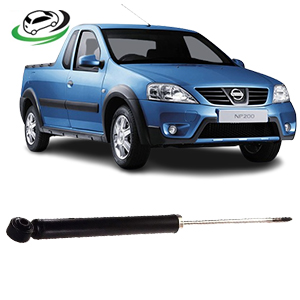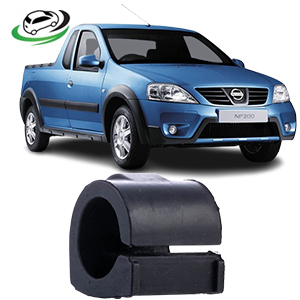-15%
Get Nissan Pick Up NP200 Bush-Rear Axle 27539
The Bush-Rear Axle, commonly referred to as a rear axle bushing, is a crucial part of a vehicle’s suspension system. It connects the rear axle to the chassis, allowing for controlled movement while absorbing vibrations, road shocks, and noise. This component plays a key role in the stability and handling of a vehicle, contributing to a smooth and comfortable ride. Although small in size, rear axle bushings are essential for maintaining the integrity and performance of a vehicle’s suspension system.
In this detailed explanation, we will cover the structure, function, types, benefits, maintenance, and symptoms of failure for the rear axle bushing.
Structure of the Rear Axle Bushing
The rear axle bushing is a simple yet effective component consisting of a few key parts. Its design is based on the need to isolate vibrations and absorb shocks while allowing some movement in the suspension system.
- Outer Metal Shell: The bushing is encased in a durable metal shell, which is typically made of steel or aluminum. This outer shell allows the bushing to be securely pressed into the rear axle or suspension arm, providing a solid connection between the axle and chassis.
- Inner Sleeve: Inside the outer shell, there is an inner sleeve that is usually made from metal as well. This inner sleeve is connected to the suspension component, allowing it to move slightly within the bushing while still providing stability.
- Rubber or Polyurethane Material: Sandwiched between the inner sleeve and the outer metal shell is a layer of rubber or polyurethane. This flexible material allows the bushing to absorb shocks and vibrations, reducing the transmission of noise and harshness to the vehicle’s chassis and cabin. The rubber or polyurethane acts as a cushion, providing damping between the suspension and the chassis.
- Bonding or Press-Fit Design: The bushing is either bonded to the inner and outer components or press-fitted into place. The tight fit prevents excessive movement while allowing the flexibility needed for suspension articulation.
Function of the Rear Axle Bushing
The primary function of the rear axle bushing is to provide a cushioned connection between the vehicle’s rear axle and its chassis, allowing for controlled movement while minimizing vibrations and noise. Bushings play a critical role in maintaining the suspension’s performance, enhancing both comfort and safety.
- Vibration and Noise Dampening: One of the main roles of the rear axle bushing is to reduce the transmission of road vibrations and noise from the axle to the chassis. The rubber or polyurethane material absorbs these vibrations, preventing them from being felt by the passengers.
- Controlling Axle Movement: The rear axle is designed to move slightly in response to changes in road conditions, such as bumps, dips, or uneven surfaces. The rear axle bushing allows for this controlled movement while preventing excessive play, ensuring that the vehicle remains stable and maintains good handling characteristics.
- Absorbing Road Shocks: When the vehicle drives over rough terrain or hits a pothole, the rear axle experiences a sudden shock. The rear axle bushing helps absorb and dissipate this shock, reducing the impact on the suspension components and providing a smoother ride.
- Maintaining Alignment: Rear axle bushings help keep the rear suspension aligned by holding the axle in place while allowing limited movement. Without these bushings, the axle could move excessively, leading to misalignment and uneven tire wear.
- Enhancing Ride Comfort: By dampening vibrations and absorbing shocks, rear axle bushings contribute to overall ride comfort. Passengers experience less harshness from road conditions, leading to a smoother driving experience.
- Improving Handling and Stability: The rear axle bushing helps maintain the stability of the vehicle, especially when cornering or driving over rough terrain. By controlling the movement of the rear axle, the bushing ensures that the tires remain in proper contact with the road, improving handling and traction.
Types of Rear Axle Bushings
There are several types of rear axle bushings, each designed for specific vehicle applications and driving conditions. The type of bushing used can significantly impact the vehicle’s performance, comfort, and durability.
- Rubber Bushings: The most common type of rear axle bushing is made from rubber. Rubber bushings offer excellent vibration dampening and ride comfort, making them ideal for everyday passenger vehicles. However, rubber bushings may wear out over time, especially under heavy loads or harsh driving conditions.
- Polyurethane Bushings: Polyurethane bushings are more rigid than rubber bushings, providing better durability and performance. They are commonly used in performance or off-road vehicles where stiffer suspension components are needed. Polyurethane bushings offer improved handling and responsiveness but may transmit more road noise and vibrations than rubber bushings.
- Solid or Spherical Bushings: Solid or spherical bushings are typically used in high-performance or racing applications. These bushings eliminate most of the flex associated with rubber or polyurethane, providing extremely precise handling. However, they do not offer the same level of comfort and are generally not suitable for daily driving.
- Hydraulic Bushings: Some modern vehicles use hydraulic bushings, which combine rubber or polyurethane with a fluid-filled chamber. These bushings offer enhanced vibration dampening and are designed to provide a smoother ride, especially in luxury or high-end vehicles. The hydraulic fluid helps to dissipate energy more effectively, improving comfort and reducing noise.
Importance of Rear Axle Bushings
The rear axle bushing is a critical component for several aspects of vehicle performance, including ride comfort, handling, and safety. Without properly functioning bushings, the suspension system would not be able to absorb shocks or control axle movement, leading to a rough and uncomfortable ride.
- Improved Ride Comfort: Rear axle bushings play a significant role in smoothing out the ride by absorbing road shocks and vibrations. This is particularly important for passenger vehicles, where comfort is a top priority.
- Better Handling and Stability: By controlling the movement of the rear axle, the bushing helps maintain stability, especially during cornering or when driving on uneven surfaces. Properly functioning bushings ensure that the vehicle remains predictable and easy to control.
- Enhanced Suspension Longevity: The bushing acts as a buffer between the rear axle and the suspension components, reducing wear and tear. This helps extend the life of other suspension parts, such as control arms, shocks, and springs.
- Reduced Noise and Vibration: Rear axle bushings isolate vibrations and road noise, improving the overall driving experience. This is especially important for vehicles that are driven over rough terrain or in urban areas with poor road conditions.
Maintenance of Rear Axle Bushings
Proper maintenance of rear axle bushings is essential for ensuring the longevity of the suspension system and maintaining ride quality. Here are key maintenance tips:
- Regular Inspection: It’s important to inspect the rear axle bushings during routine vehicle maintenance. Look for signs of wear, such as cracks in the rubber, excessive movement, or any fluid leaks from hydraulic bushings.
- Check for Noise or Vibration: If you notice increased noise, vibration, or clunking sounds coming from the rear suspension, it could indicate that the rear axle bushings are worn or damaged. These noises often occur when the bushing has deteriorated, allowing metal components to contact each other.
- Replace Worn Bushings: Rear axle bushings should be replaced if they show signs of wear or damage. Worn bushings can lead to poor handling, increased tire wear, and a rough ride. Depending on the material, bushings may need to be replaced every 50,000 to 100,000 miles.
- Lubrication (if applicable): Some bushings, especially polyurethane types, may require periodic lubrication to reduce friction and extend their lifespan. Be sure to use the correct type of lubricant recommended by the manufacturer.
Symptoms of Failing Rear Axle Bushings
Several signs can indicate that your rear axle bushings are failing, including:
- Excessive Noise: Clunking, knocking, or rattling noises from the rear of the vehicle are common signs of worn or damaged bushings. These noises occur when the bushing has degraded, allowing metal components to make contact.
- Increased Vibration: A worn rear axle bushing can no longer absorb vibrations effectively, leading to increased vibrations felt in the cabin, especially when driving over rough terrain.
- Poor Handling: If the vehicle feels unstable, sways excessively during turns, or has trouble maintaining alignment, it could be due to worn rear axle bushings. The axle may move more than it should, affecting handling and stability.
- Uneven Tire Wear: Failing bushings can cause the rear axle to move out of alignment, leading to uneven tire wear. This can reduce tire life and impact the vehicle’s handling.
- Visual Inspection: If you see cracks or tears in the rubber or polyurethane of the bushing, or if there’s noticeable movement in the rear axle, it’s a clear sign that the bushings need to be replaced.
Conclusion
The Rear Axle Bushing is a vital component of a vehicle’s suspension system, responsible for controlling the movement of the rear axle, reducing vibrations, and absorbing road shocks. By providing a cushioned connection between the axle and the chassis, bushings play a crucial role in enhancing ride comfort, handling, and overall vehicle stability. Proper maintenance, such as regular inspections and timely replacement of worn bushings, can ensure the longevity of the suspension system and contribute to a smoother, safer driving experience. Recognizing the signs of failing bushings—such as increased noise, vibrations, and poor handling—is key to maintaining optimal vehicle performance.
Follow us on Facebook for more parts.



